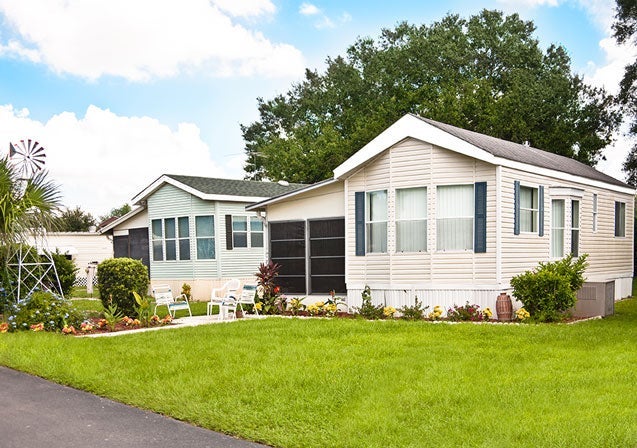The terms “mobile home” and “manufactured home” are often used interchangeably, but if you want to apply for a reverse mortgage, there is an important difference between them. Learn what distinguishes a manufactured home from a mobile home, and which is eligible for a reverse mortgage.
The difference between a mobile home and a manufactured home
Mobile homes are manufactured in a factory and permanently affixed to a chassis or the vehicle’s base frame. Manufactured homes are also made in a factory. However, manufactured homes are permanently affixed to a foundation, often sold with the land, and taxed as real estate.
There are multiple ways to determine if your home is a mobile home or a manufactured home. For instance, if your home is registered with the DMV like a vehicle and you rent a space to park it, you have a mobile home.
Another way to tell what type of home you have is by the year it was built. In 1974, Congress passed the National Manufactured Housing Construction and Safety Standards Act, which gave HUD the authority to establish a national building code for manufactured homes. After June 15, 1976, all manufactured homes were required to follow this code.
Manufactured homes and reverse mortgage eligibility
Mobile homes are not eligible for reverse mortgages, but certain manufactured homes are. The following guidelines are specifically for Home Equity Conversion Mortgages (HECMs) the only reverse mortgage insured by the U.S. federal government. Property eligibility requirements for a proprietary reverse mortgage vary by lender.
To be eligible for a home equity conversion mortgage (HECM), a manufactured home must meet the following Department of Housing and Urban Development (HUD) requirements:
- Minimum floor area. The manufactured home’s floor area must be no less than 400 square feet.
- Comply with building requirements. The manufactured home must be connected to the home’s foundation and must be built on a permanent chassis, meaning it cannot be removed from the framework.
- Built after a specific date. To qualify for a reverse mortgage, the manufactured home must have been constructed after June 15, 1976.
- Seal. The manufactured home must have a seal that shows it was built in compliance with the Federal Manufactured Home Construction and Safety Standards. Generally, homes built after June 15, 1976, will have this seal.
- Tax classification. The manufactured home must be classified and taxed as real estate.
- No previous occupation. For reverse mortgage eligibility, the manufactured home cannot be occupied or have been previously installed at any other site or location.
- Permanent Foundation. The home must sit on a permanent foundation.
- Land ownership. The borrowers must own the land that the manufactured home sits on.
- Grade elevation requirement. The elevation beneath the home must have finished grade elevation. The floor must be at or above the 100-year flood elevation if a basement is used. In other words, they cannot be in a flood zone.
- Engineer Certification. An engineer must certify the foundation.
Additional reverse mortgage property requirements
In addition to the home meeting HUD’s requirement, there are also additional requirements a lender may impose. Those requirements are generally as follows but may vary from lender to lender:
- Unit size requirement. The borrower can only qualify for a double-wide unit. No single-wide units are eligible.
- Credit report verification. The lender will verify that there are no outstanding personal liens on a dwelling.
- HUD tag requirement. Each manufactured home section must have HUD tags accessible to the appraiser. In addition, the appraiser must certify that the home’s seal isn’t compromised.
- Appraisal of comparable sales. Comparable sales must be within one mile in urban areas or within 20 miles in rural areas.
- Cannot be a part of a condominium complex. No manufactured home can be located as a part of a manufactured condominium complex.
Speak with one of our licensed loan officers to find out if your manufactured home meets the eligibility requirements for a HECM.



